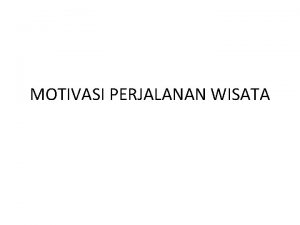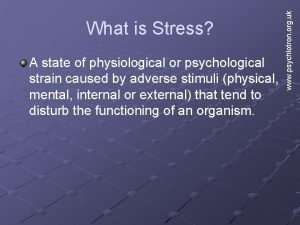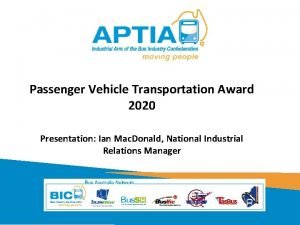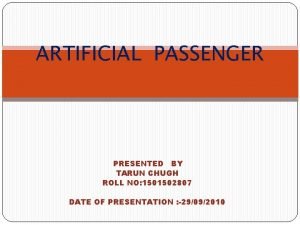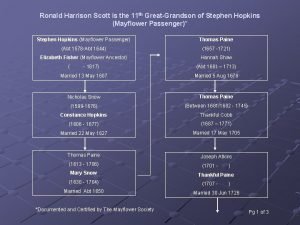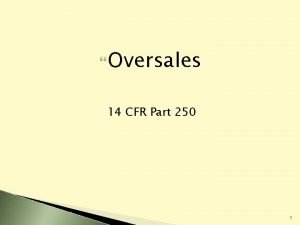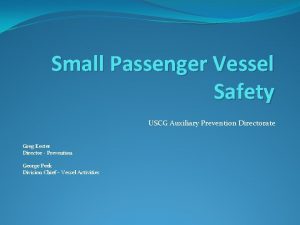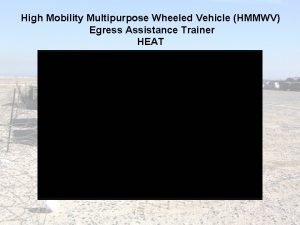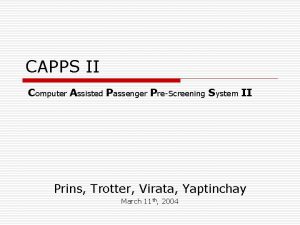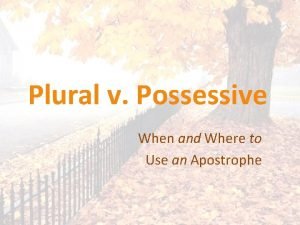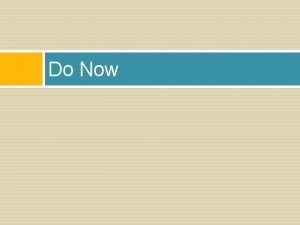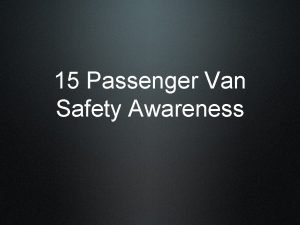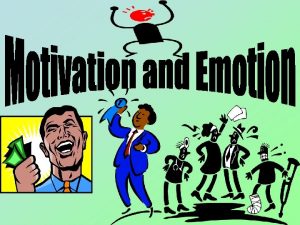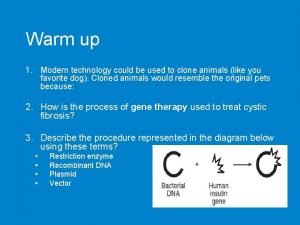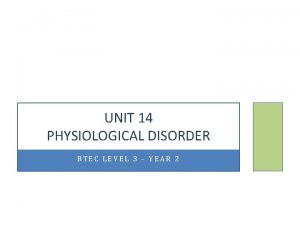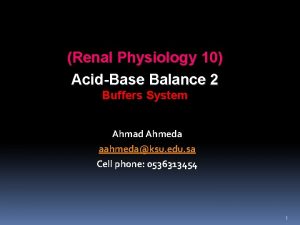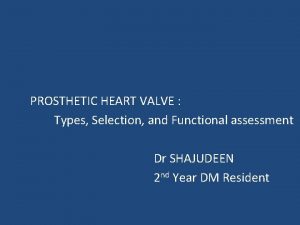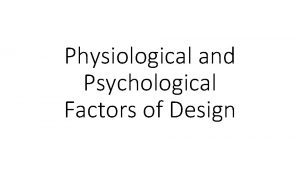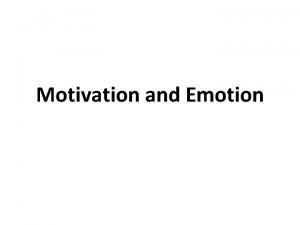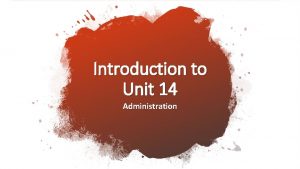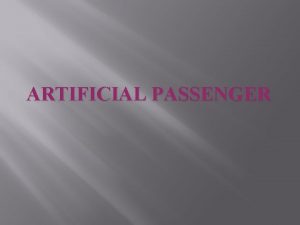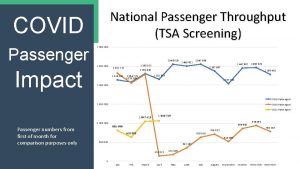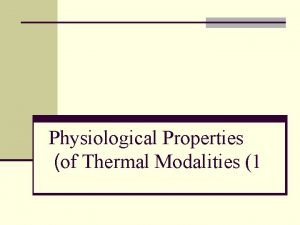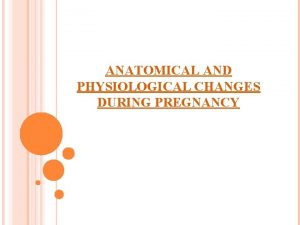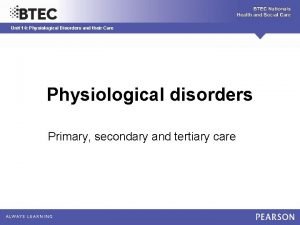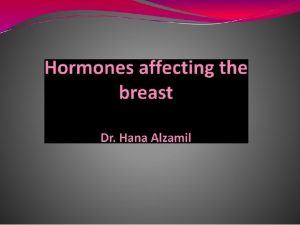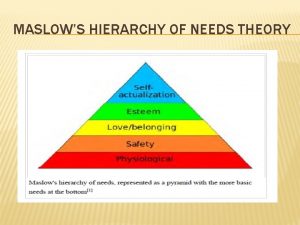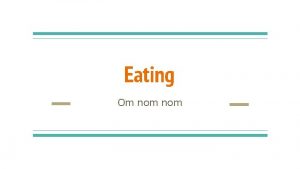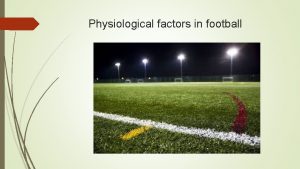Passage Passenger Power Psychoemotional Physical physiological Psychoemotional state













































- Slides: 45




ﻋﻮﺍﻣﻞ ﻣﻮﺛﺮ ﺩﺭ ﺳیﺮ ﻟیﺒﺮ Passage Passenger Power • Psycho-emotional • Physical • physiological

Psycho-emotional state of mother(reducing maternal distress) Maternal effects of anxiety (‘ fight or fight ’ response) in labor Excessive catecholamine levels in first stage labor cause: blood flow to uterus uterine contractions duration of first stage labor blood flow to placenta oxygen available to fetus fetal production of catecholamines fetal conservation of oxygen fetal heart rate decelerations negative or pessimistic perception of words or events by woman need for reassurance & support, protectiveness towards fetus Excessive catecholamine levels in second stage labor causes: same fetal effects as listed above ‘ fetal ejection reflex ‘ (rapid expulsion fetus)

Physical and Psycho – emotional measures Before Labor: üBirth plan During Labor: üIntroduce yourself & her to unit üAsk about her plans & preferences üEncourage an atmosphere of privacy, comfort, üExplain any clinical procedures or tests üInform mother of signs of progress üSuggest comfort measures üReassure the mother intimacy

Physiological measures v Encourage to empty her bladder v Well hydrated but not over hydrated v Encourage to seek comfort v Encourage to relax her voluntary muscles

Techniques to Elicit Stronger Contraction ¯ Hydratation ¯ Movement and Position ¯ Comforting touch ¯ Nipple Stimulation ¯ Warm compress Prolonged Pre Labor and Latent first Stage When is a woman in Labor? Friedman’s Definition O’ Driscoll ‘s Definition

Prolonged Pre-Labor or Latent first Stage Prolonged pre- labor or latent phase • Time • Rest • Nurture self: eat, drink • Labor- stimulating measures • Distraction • Emotional support • No artificial rupture of the membranes • Diagnosis: pre- labor or true labor? Prostaglandin gel, or drug- induced rest Pitocin induction/ augmentation Cesarean Section Active labor



• Semi setting Position move the fetus ‘s center of gravity toward her back Synclitisme Position • Abdominal lifting: realigned the angle between the baby ‘s torso and the pelvic in let Prolonged active Phase Definition: insufficient rate of dilatation after active labor w Less than 1 cm/h at least 2 h w Less than 1. 2 cm/h PP w Less than 1. 5 cm/h MP w Longer than 12 h from 4 cm to Complete dilatation

Possible Causes: Ø Malpositions: occiput posterior, presistent occiput transverse position, or presistent asynclitism. Ø Macrosomia, CPD Ø Inadequate and the intensity of contractions. Ø Presistent cervical lip. Ø Emotional dystocia ‘ : fear, anxiety, tension, or hostility. Ø Maternal exhaustion, dehydration. Ø Maternal physical factors: severe lumbar lordosis (especially if combined with a lack of mobility in the lumbar spine), or a pendulous abdomen, due to lack of abdominal muscle tone. Ø Combination of etiologies or unknown etiology.

Malposition, Macrosomia and Cephalopelvic Disproportion Diagnostic: A dip in the supine Woman ‘s abdomen Abdominal Shape at the level of ombilic Abdominal Palpation OP Internal examination



Matrenal Position and Movement Occiput posterior / asynclitism in first stage Try to determine position (LOP, ROP, or asynclitic) Time / maintenance Rotate baby: Deal with back pain - Positions - Knee–chest position - Pressure - Hands and Knee - Hydrotherapy - Pelvic rock - Tens - Lunge - I-D sterile H 2 O - Abdominal stroking - Cold / heat - Abdominal lifting - Walk / movement Monitoring fetal heart rate contraction - Avoid pushing arom I-V narcotics or epidural block Pitocin Time No progress or fetal distress Cesarean section Rotation and progress

- Forward. Leaning Position (May aid Fetal repositioning)



What this Position does. . . - Side lying Positions


Asymmetrical Position and Movements This may allow more space where it is needed for rotation If the baby is OP, the woman should lunge in the direction of the occiput


Note regarding supine and semi-sitting positions for occiput posterior When a woman is fully supine or semi-sitting, gravity encourages the trunk of the Op fetus to lie next to the woman ‘s spine, increasing the changes of supine hypotension, but also minimizing the likelihood or rotation to OA. These positions also increase the pressure of the fetal occiput against the woman ‘s sacrum, thus worsening her back pain (Fig. 4. 25 a). There is a much greater likelihood of rotation, and less back pain when the woman sits upright or leans forward. (Fig. 4. 25 b). When a woman is supine, the head of an occiput posterior fetus is directed more toward the pubic bone during contraction (Fig. 4. 26 a). When the woman is upright, the uterus, tilting forward, direct the fetal head into the pelvic basin (Fig. 4. 26 b).



Positions for tired women

Presistent Cervical lip or a Swollen Cervix

Emotional dystocia How to help a woman for whom emotional distress is a likely cause of labor dystocia Anxiety or Distress in Labor: “ Emotional Dystocia “ Check psychosocial history Comfort measures - Bath / shower - Massage / soothing touch - Breathing / relaxing, etc. Psychological intervention - ‘ What ‘s going through your mind? - Reassurance / education - Visualizations Kindness / respect Patience Doula Rest with narcotics and / or epidural (depending on phase of labor) Oxytocin AROM Cesarean section Improved labor progress

Prolonged Second Stage Definition: Complete dilatation of Cervix and ends with the birth of baby Latent phase: Lull in uterine activity around the time of Complete dilatation = resting phase = rest and be thankful It is probably a physiological phenomenon relating to the retraction of the Cervix around the head and the descent in to Vaginal Canal What is the latent phase of the Second Stage Persists In the lull in uterine activity persists for more than 20 or 30 min: Æ Monitoring Æ Sitting up right ( in bed or on the toilet) Æ Squatting Æ Walking Æ (Acupressure, nipple Stimulation)

Solution for Second Stage dystocia Position and other Strategies for Suspected OP , OT l Leaning forward while Kneeling, Standing or Sitting


Encourage rotation of the trunk from Posterior Back pain is relieved l Squatting Position enlarge the Space in the Pelvic

What does Position does? Provides gravity advantage Enlarges Pelvic outlet by increasing the inter tuberous diameter May require less bearing - down effort than horizontal Positions May enhance urge to push May enhance fetal descent May relieve backache If continued for a prolonged Period, Compresses the blood vessels and nerves located behind the Knee Joint What not to use Squatting? Joint injury, arthritis, Weakness in legs When fetal head has not reached the level of the ischial Spines

l Asymmetrical Positions


Lateral Positions Attention: the Same side as the Posterior Occiput if side lying the Side opposite the Posterior or Transverse occiput if in exaggerated Sims


Supported Squat or “dangle” Position Provide more Vertical Space for the fetus

Other Strategies § Pelvic Press : v Increase mid pelvis and Outlet dimension

Attention: There is different between Pelvis Press and double hip Squeeze § Pelvic Rocking :



Occiput Posterior / Asynclitism in Second stage Time / maintenance Rotate baby: - Hands and Knee - Lunge - Abdominal lifting - Knee – chest - Upright, asymmetrical positions - Dangle - Pelvic press Deal with back oain Spontaneous pushing Monitor FHR / contractions § Directed pushing § Time Fetal distress / no progress § Episiotomy § Forceps § Vacuum extractor Cesarean section Rotation / descent Vaginal birth
 Passage power passenger
Passage power passenger Yang dimaksud dengan motivasi interpersonal adalah...
Yang dimaksud dengan motivasi interpersonal adalah... Physiological state
Physiological state Power triangle
Power triangle Passenger vehicle transportation award
Passenger vehicle transportation award Safety passenger brief
Safety passenger brief What is artificial passenger
What is artificial passenger 15 passenger van safety training
15 passenger van safety training Passenger management system
Passenger management system Stephen hopkins mayflower passenger grandchildren
Stephen hopkins mayflower passenger grandchildren Dodo passenger pigeon
Dodo passenger pigeon Confirmed revenue passenger oversales
Confirmed revenue passenger oversales Uninspected passenger vessel
Uninspected passenger vessel Passenger vessel safety act of 1993
Passenger vessel safety act of 1993 Your passenger jammed his finger in the door of your m1114
Your passenger jammed his finger in the door of your m1114 Safest 15 passenger van
Safest 15 passenger van Computer assisted passenger prescreening system
Computer assisted passenger prescreening system Passenger plural possessive
Passenger plural possessive A pilot at an airshow charges $25 per passenger
A pilot at an airshow charges $25 per passenger Classification of station
Classification of station Definition of work physics
Definition of work physics Unit22 virgin
Unit22 virgin Passenger transport safety
Passenger transport safety Upon landing the front passenger 180 pounds
Upon landing the front passenger 180 pounds 15 passenger van safety training
15 passenger van safety training Price fences marketing
Price fences marketing Physical fitness test grade 9
Physical fitness test grade 9 Whats an adaptation
Whats an adaptation What is emotion
What is emotion Why is artificial selection used
Why is artificial selection used Unit 14 physiological disorders health and social care
Unit 14 physiological disorders health and social care Unit 14 task 2
Unit 14 task 2 James lange theory of emotion
James lange theory of emotion Physiological phonetics
Physiological phonetics Physiological buffer system
Physiological buffer system Reading as a physiological process
Reading as a physiological process Dvi aortic valve
Dvi aortic valve Crude population density vs physiological density
Crude population density vs physiological density Physiological perspective
Physiological perspective Chassis leakage current
Chassis leakage current Physiological design
Physiological design Physiological factors affecting performance
Physiological factors affecting performance Name something associated with china
Name something associated with china What is motivation
What is motivation Smart bristow faradic coil
Smart bristow faradic coil Unit 14 physiological disorders assignment 1
Unit 14 physiological disorders assignment 1

